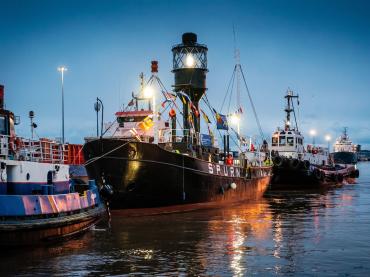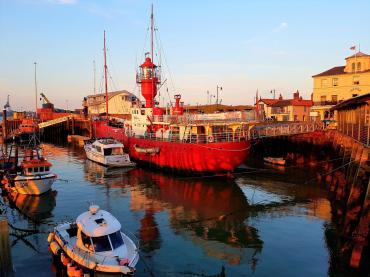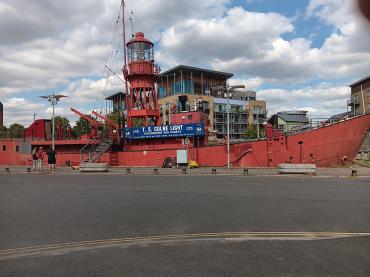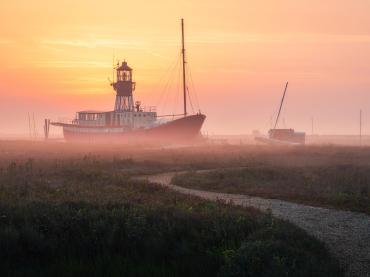


Previous names
- 1937 LV no. 91
Details
Construction
Dimensions
History
This light vessel was built as No. 91 for the Corporation of Trinity House by Philip and Son Ltd. of Dartmouth in 1937. She was deployed on various stations, her first being the Humber from 1937 to 1942. On 3 April 1942 she was damaged in collision with steamer MAURICE ROSE and again on 1 September 1942, she was hit by the steamer ARMATHIA. She moved to her final station, the Helwick, off the Worm's Head, for the last six years of her sea-service from 1971 to 1977.
Like nearly all lightships she is not self-propelled, being towed to each station by a tug. Her diesel engines were used to generate electricity to power the light and to make compressed air to operate the fog horn. LV 91 had eight 110 volt (375 watt) lamps giving 650,000 candle power. Whilst stationed on Helwick her lamp sequence was 0.5 second flash and 9.5 second eclipse. Her fog horn, powered by compressed air at 35lbs per square inch sounded one blast of three seconds followed by twenty seven seconds of silence. Her full complement of crew was two masters and nine men who rotated on a four week cycle with only seven onboard at any one time. The crew were relieved by boat right up until her retirement as the layout of the deck with two masts meant that there was no space to build a landing platform for helicopters.
Swansea Museum acquired LV 91 in 1977 with a 50% grant from the Science Museum and monies raised by The Friends of the Maritime and Industrial Museum.
Source; David Jenkins, Advisory Committee, March 2009
Significance
What is the vessel’s ability to demonstrate history in her physical fabric?
LV 91 was ordered by Trinity House in 1936 and delivered in 1937 following construction at Philip & Son yard in Kingswear, nr Dartmouth Devon.
Built to standard Trinity House design, her level of originality is high with hull fabric, structures and fittings as built. She maintains her machinery compartment with the diesel generators that were used to charge her batteries to power the lantern along with the diesel driven compressors that filled air reservoirs that would power the foghorn. The signals cabin is still equipped with the original Marconi telecommunications equipment. Her accommodation, galley and mess area remain complete and unaltered since coming out of service in 1977. This offers an insight into what life would have been like on board for the captain and crew. Being unpowered, light vessels were towed to their stations by tugs and then relied on 3 mushroom anchors to secure them in position. The chain lockers and lengths of chain remain visible. With the advent of helicopters, many light vessels had the aft mast removed so that a helideck could be fitted for crew changes. This modification was not carried out on LV 91, so she maintains her original mast and rig configuration. Crew changes would have been carried out by support vessels from the nearest port, making it a very weather dependent operation.
Work on the vessel has been limited to preservation by maintenance, focused on paintwork and scheduled dry dockings to check hull thickness. Such maintenance has not been completed since 2018, leading to a general degradation of the vessel’s appearance and damage to some internal fabric due to water ingress.
What are the vessel’s associational links for which there is no physical evidence?
LV 91 was built in Kingswear, nr Dartmouth at the yard of Philips and Son which operated from 1858 until the late 1990s. Upon closing, it was the last shipyard on the river Dart, this site being turned into a marina and leisure complex. Philip and Sons was a large local employer. A full range of vessels were constructed by the company, including 26 light vessels for Trinity House and 230 vessels of various types for the admiralty during the years spanning the second world war.
LV 91 was stationed in two locations during her career. From 1937 to 1971 she served as HUMBER and was positioned off the mouth of the Humber River in the North Sea. During this time two events of note occurred, On 3 April 1942 she was damaged in a collision with the steamer MAURICE ROSE and again on 1 September 1942, she was hit by the steamer ARMATHIA. From 1971 until her withdrawal from service in 1977, LV 91 was stationed to mark the Helwick Sands off the Gower Peninsular, nr Swansea in Wales.
Upon release from service, Trinity House sold LV 91 to Swansea Council as an afloat attraction at the marine development in the city. She has become a popular sight at this location and forms a focal point outside the National Waterfront Museum.
How does the vessel’s shape or form combine and contribute to her function?
Designed and built as a light vessel, her hull shape and form were specifically developed to remain anchored to mark a navigation hazard in all weathers and sea states. Her internal machinery space provides easy access to operate and maintain the diesel machinery required to charge her batteries and provide compressed air for her light and fog horn. Crew accommodation was provided for Captain and up to 4 crew who maintained and operated the navigation equipment 24/7.
Light vessels symbolize to us beacons of hope and guidance, they are aesthetically pleasing in form and appearance when maintained in the usual striking red colour scheme with their names clearly annotated on the side of the hull in large white letters.
Key dates
-
1937
Vessel built for the Corporation of Trinity House by Philip & Son Ltd, Dartmouth, Devon
-
1937-1942
Operated on Humber station
- 3 April 1942 Damaged in collision with steamer MAURICE ROSE
- 1 September 1942 Damaged in collision with steamer ARMATHIA
- 1971-1977 On station at Helwick
- 1977 Sold to Swansea Museum
Sources
Helwick Light Vessel No. 91, Swansea Maritime Museum
Brouwer, Norman J, International Register of Historic Ships, Anthony Nelson, pp153, Edition 2, 1993
Own this vessel?
If you are the owner of this vessel and would like to provide more details or updated information, please contact info@nationalhistoricships.org.uk
















